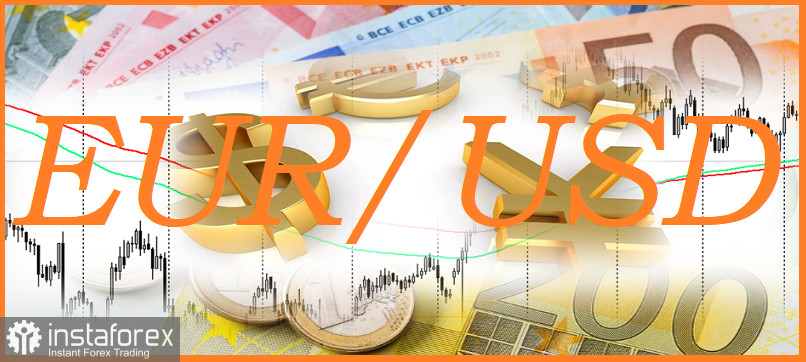
EUR/USD refers to pairs with a reverse currency quote and indicates how many units of the US national currency (dollar) must be paid for one euro. The base currency in the EUR/USD pair is the euro. This means that the commodity in the EUR/USD pair is the euro, and the US dollar is the second currency in the pair, with which the base currency (the euro) is bought. The euro, like the dollar, is included in the IMF basket, which consists of five major world currencies (in descending order): US dollar, euro, yuan, yen, and pound sterling. At the same time, the euro and the dollar are the world's largest reserve currencies. They account for approximately 80% of the total basket of world reserve currencies. The EUR/USD pair belongs to the category of "major" currency pairs along with the USD/JPY, GBP/USD, AUD/USD, USD/CHF, USD/CAD, and NZD/USD currency pairs.
At the moment, the EUR/USD pair is trading on the Forex market at a price close to 1.0740. This means that for one euro they give 1.0740 US dollars.
Features of trading the EUR/USD pair
1. According to various estimates, the EUR/USD pair accounts for approximately 30% of the total trading volume on the foreign exchange market. And the number of transactions on the EUR/USD pair reaches 70% of the total volume of transactions. This is the most liquid currency pair. Both the dollar and the euro are highly liquid currencies. Almost at any moment there will be both buyers and sellers for the dollar or the euro. The European Union and the United States have the strongest world economies. The United States is in first place in the world in terms of GDP, and Germany, whose economy is the locomotive of the Eurozone economy, is in 4th place in terms of GDP. The share of the United States in world GDP is approximately 25%, and the share of the Eurozone is 17%.
2. The EUR/USD pair is actively traded throughout the trading day. The highest peak of trading activity with the euro and the EUR/USD pair and the largest trading volumes occur during the European session (06:00 – 16:00 GMT) and the American session (12:00 – 22:00 GMT). Moreover, the time between the beginning of the session in New York (12:00) and the end of the trading session in London (16:00) will be the most active, since the two trading sessions overlap at this time, and European and US traders are involved in trading.
3. A surge in trading volatility in the EUR/USD pair occurs during the publication of important macroeconomic indicators for the US, the Eurozone, and Germany. The following macroeconomic factors and indicators give the greatest volatility to the EUR/USD pair:
Decisions of the Fed and the ECB regarding monetary policy in the US or the euro area;Speeches by the heads of the Fed and the ECB (currently Jerome Powell and Christine Lagarde, respectively);Publication of minutes from the latest meetings of the Fed and the ECB on monetary policy issues;Data from the labor market of the USA, Eurozone, Germany;Data on GDP of the USA, Eurozone, Germany;Publication of inflationary indicators of the USA, Eurozone, Germany.
Strong macroeconomic indicators in the US or the eurozone lead to the strengthening of the dollar or the euro, respectively, as they contribute to the growth of "tough sentiment" of the central banks of the United States or the eurozone regarding an interest rate increase. And this is a positive factor for the national currency, which leads to an increase in its value.
4. Important political events in the US, the euro area, and the world also affect the quotes of currencies, primarily the dollar and the euro. In addition, the dollar and the euro are funding currencies and are directly related to the current situation in the US or Eurozone stock market. The sale of risky assets in the stock markets of the US or Europe, as a rule, leads to an increase in the value of the dollar and the euro, respectively. The sale of US government bonds or, say, Germany is accompanied by an increase in their yield and the value of the dollar or euro, respectively. And vice versa. The growth of the stock market in the US or the Eurozone, as a rule, is accompanied by a decrease in the value of the dollar or euro.
5. In relation to other "major" currency pairs, there is a fairly strong correlation of the EUR/USD pair with the AUD/USD (86%), NZD/USD (86%), and XAU/USD (71%) pairs. Significant inverse correlation of EUR/USD with USD/CHF (95%) and USD/JPY (73%).
6. The intraday volatility of the EUR/USD pair fluctuates in different periods of the year. On average, it ranges from 50 to 120 points, but can exceed 300 points during periods of publication of important news of a political or economic nature.
 English
English 
 Русский
Русский Bahasa Indonesia
Bahasa Indonesia Bahasa Malay
Bahasa Malay ไทย
ไทย Español
Español Deutsch
Deutsch Български
Български Français
Français Tiếng Việt
Tiếng Việt 中文
中文 বাংলা
বাংলা हिन्दी
हिन्दी Čeština
Čeština Українська
Українська Română
Română

